Using readability analysis to make students stronger writers
Communication is one of 5 common competencies developed throughout CEGEP education. College students turn in written work in most, if not all, of their courses. Thus, to hone their writing skills, they need sustained support across classes. Training students on the concept of readability may help them become more mindful and effective readers and writers.
What is the readability of a text?
Readability is “the ability of the text to communicate the intention of the writer to the intended reader” (Prins & Ulijn, 1998). In other words, the concept expresses how easy it is to read and understand a text. This depends on a variety of factors, including:
- Presentation ( typography and formatting)
- Content ( precision and coherence of ideas)
- Structure ( paragraphs and headings)
- Language mechanics ( vocabulary and syntax)
Not all of these elements are quantifiable, but readability software tools can yield accurate and useful analysis of a text’s structure and language mechanics – often considered the best predictors of text difficulty. In turn, this insight can inform students on the clarity of their presented content.
Most readability analysis formulas consider:
- The number of letters or syllables in words
- The number of words in sentences
Certain calculations also include other elements:
- Word structure complexity (Gunning Fog index)
- Word meaning difficulty (Dale-Chall formula)
These calculations indicate the estimated number of years of education a person needs to be able to easily understand a text on the first reading. As a reference point, most general press articles have a grade 7 – 9 reading level.
| Grade reading level | Type of information |
|---|---|
| Grade 5 – 6 (primary school completed) |
Essential information for a diverse public, including marginal readers and people who are learning English as a second language |
| Grade 7 – 9 (secondary 1 – 3) |
Information intended for the general public, including specific terms and abstract concepts |
| Grade 10 – 12 (secondary 5 / college) |
Specialized information intended for an audience of fluent readers |
| Grade 13 – 15 (university) |
Specialized information for an audience that is well-informed on the subject area |
| This chart (adapted from How to Write Plain English) shows the reading level ranges language experts recommend based on a text’s purpose and genre. | |
These tools differ from spelling or grammar checkers, such as the one included in MS Word. Their point is not to automatically fix students’ mistakes, but to give them a deeper understanding of their writing habits. This, of course, will ultimately lead them to also become more aware of and avoid language errors – whether they are native English language users or second language learners.
| Flesch-Kincaid readability scores and levels | Common European Framework of Reference for Languages |
|---|---|
| 0-50: Very difficult (Higher education level) | C2 Mastery |
| 50 – 60: Fairly difficult (high school completed) | C1 Advanced |
| 60 – 70: Plain English (used by most general news media) | B2 Upper intermediate |
| 70 – 80: Fairly easy (accessible to students aged 13 upwards) | B1 Intermediate |
| 80 – 90: Easy (conversational English on general topics) | A2 Elementary |
| 90 – 100: Very easy (end of primary school) | A1 EFL beginners |
| This chart (adapted from Linguapress) correlates reading level ranges to language learners’ ability levels defined by the Common European Framework of Reference for Languages. | |
Two free readability analysis tools for English text
Readable.io offers a free readability analysis of any English text you copy-paste into its editor.
- It applies several of the algorithms mentioned above, so you can pinpoint specific characteristics of your text.
- It calculates an average score to give you quick insight into its overall readability.
- It identifies long words and sentences considered too complex.
- It appraises the tone of the text (positive or negative) and its gender-neutrality.
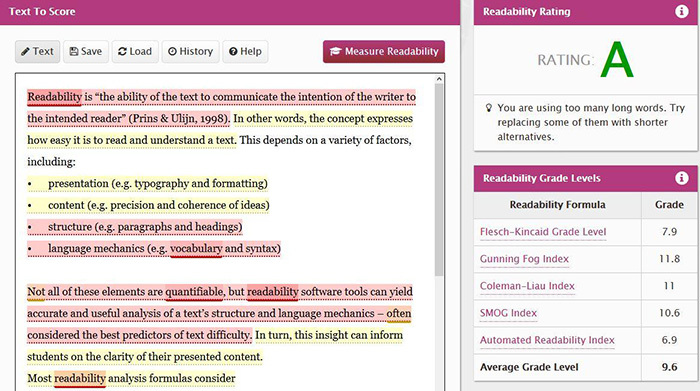
Readable.io rates the introduction of this article “A,” with an average grade level of 9.6. This meets the criteria for plain English. The presence of long words is justifiable because the target audience consists of professionals with a university-level education.
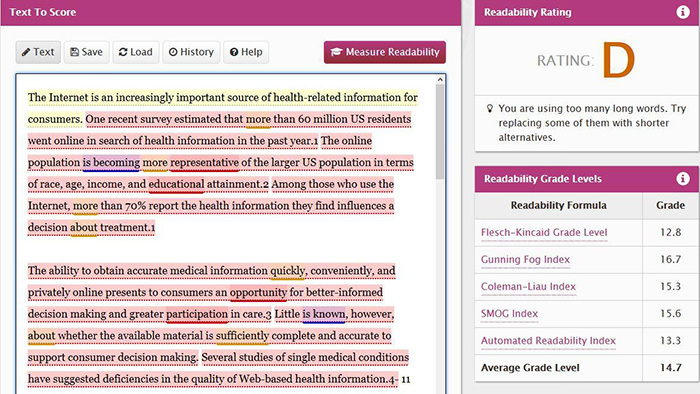
An academic article on the topic of readability is rated “D,” with an average grade level of 14.7. This means it is more difficult to read than the current text, yet well-adapted to its academic target audience.
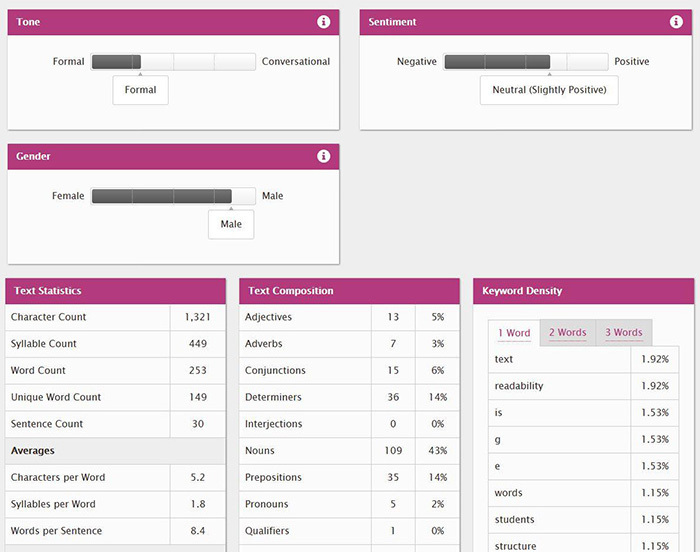
Readable.io also provides more in-depth analytics.
Gradeproof has more advanced analytical features. It provides feedback and suggestions on:
- Syntax, including sentence types and length
- Vocabulary, including word choice and level of language
- Style and eloquence
It requires you to sign up for a free account and also offers paid subscriptions with more advanced features. You can copy-paste directly into the online editor. There is also an app that directly integrates with Google Docs.
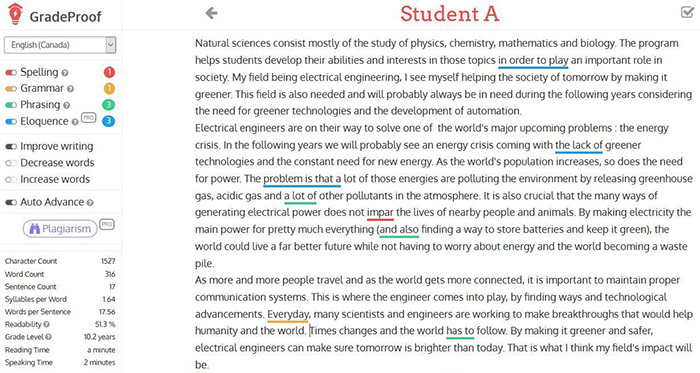
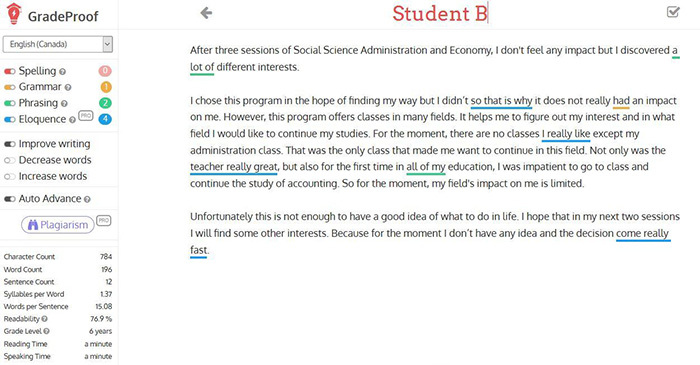
The Gradeproof analysis shows that student A writes at a higher grade level than student B, which is more appropriate for a college-level essay. The items categorized under “eloquence” point out where student B can improve word choice. This will increase the readability grade level.
Integrating readability analysis into your lessons
Successfully training students to consider readability when they write requires a 3-step strategy:
- Analyze your own instruction documents to validate their clarity. Include readability scores on your handouts, so your students are regularly exposed to these numbers and what they represent.
- Give your students sample documents to analyze. This will help them understand, for instance, that a technical report typically has a higher grade reading level and more complex lexical and grammatical forms than a summary intended for the general public.
- Ask students to include readability statistics whenever they produce an electronic written document. Get them to self-reflect on what the numbers mean and what kind of adjustments they need to make as a result. You can even suggest a benchmark range for students to attain, or specific language features for them to focus on.
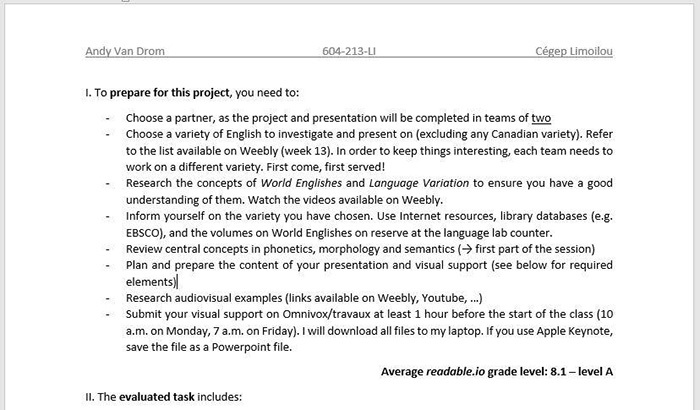
Systematically including readability levels on your handouts helps students develop a better understanding of them – and ensures your instructions are easy to read.

Analyzing example excerpts with students shows them how to express ideas more clearly.
Readability is a stepping stone
Recurring criticism of readability analysis points out that:
- These formulas cannot predict if the target audience will actually understand the text.
- They often don’t pinpoint where and how you need to correct a text to improve its readability.
This can actually be an asset for teaching purposes. Instead of giving students easy click-to-correct options, readability scores and more in-depth lexical and syntactical analyses incite them to reflect on their writing. Other pedagogical uses of readability analysis include:
- Ensuring course notes and instructions are clear for all students, as part of an inclusive approach
- Validating the difficulty level of reading comprehension tests or document use tasks
- Supporting students in the development of media literacy
Analyzing sample texts as well as students’ own writing also emphasizes the interactive process between the reader, the text, and the writer. This awareness turns “writing for a grade” into “writing for an audience, with purpose.

